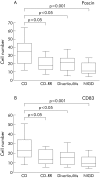Increased number of mature dendritic cells in Crohn's disease: evidence for a chemokine mediated retention mechanism
- PMID: 16118351
- PMCID: PMC1856494
- DOI: 10.1136/gut.2004.063008
Increased number of mature dendritic cells in Crohn's disease: evidence for a chemokine mediated retention mechanism
Abstract
Background and aims: Activation of T cells by dendritic cells (DC) is thought to play a pivotal role in induction and maintenance of Crohn's disease. Detailed analyses however concerning the phenotype and maturation of DC as well as the mechanisms underlying their recruitment are still lacking for Crohn's disease.
Methods: Different myeloid and plasmacytoid DC subsets were characterised by immunohistochemistry. Expression of the so-called "lymphoid" chemokines CCL19, CCL20, and CCL21 was determined by real time reverse transcription-polymerase chain reaction in Crohn's disease and normal controls. Furthermore, expression of CCL19, CCL20, and CCL21 as well as their receptors CCR6 (for CCL20) and CCR7 (for CCL19 and CCL21) was characterised by immunohistochemistry and, in addition, their cellular localisation was determined by double immunofluorescence investigations.
Results: Colonic tissue affected by Crohn's disease was characterised by an increased number of mature myeloid DC forming clusters with proliferating T cells. In keeping with their advanced maturation, DC possess the chemokine receptor CCR7. Increased expression of the CCR7 ligands CCL19 by DC themselves as well as CCL21 by reticular cells and lymphatic vessels was observed in Crohn's disease, thereby causing the matured DC to be trapped at the site of inflammation.
Conclusion: Our results demonstrate that autocrine and paracrine actions of lymphoid chemokines in Crohn's disease may lead to increased numbers of mature DC away from their usual migration to lymphoid organs and result in the development of a tertiary lymphatic tissue within the bowel wall maintaining the autoimmune inflammation in Crohn's disease.
Conflict of interest statement
Conflict of interest: None declared.
References
MeSH terms
Substances
LinkOut - more resources
Full Text Sources
Other Literature Sources
Medical





